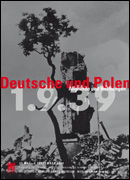


Exhibition | Oppression and Self-assertion | War and Occupation | Conflicts and Rapprochements
The Invasion
| Forced Labor
| Colonization, Deportation, Extermination
Genocide
| Resistance and Self-assertion
The End of the War
| Expulsion of the Germans
| Expulsion of the Poles
Millions of Poles were driven from their homes by the Germans during World War Two, and resettlements continued after the war.
The Soviet Union laid claim to the part of Eastern Poland which was assigned to the Soviets in the Hitler-Stalin Pact of 1939. The Polish residents of these areas were expelled. Meanwhile, hundreds of thousands of Ukrainians, White Russians and Lithuanians were forced to leave their homes in Poland and resettle in the Soviet Union. Poland's communist-dominated provisional government approved the population transfer, following the line dictated by the Soviet Union. But the government also hoped that the absorption of more ethnic Poles would make Poland a stronger nation.
Most of the expelled Polish population, about 1.5 million in all, made their new homes in the areas taken from Germany after the war. The government also called for volunteers from Central Poland to settle the newly acquired territories, revive their economy and place a Polish stamp on the region.
